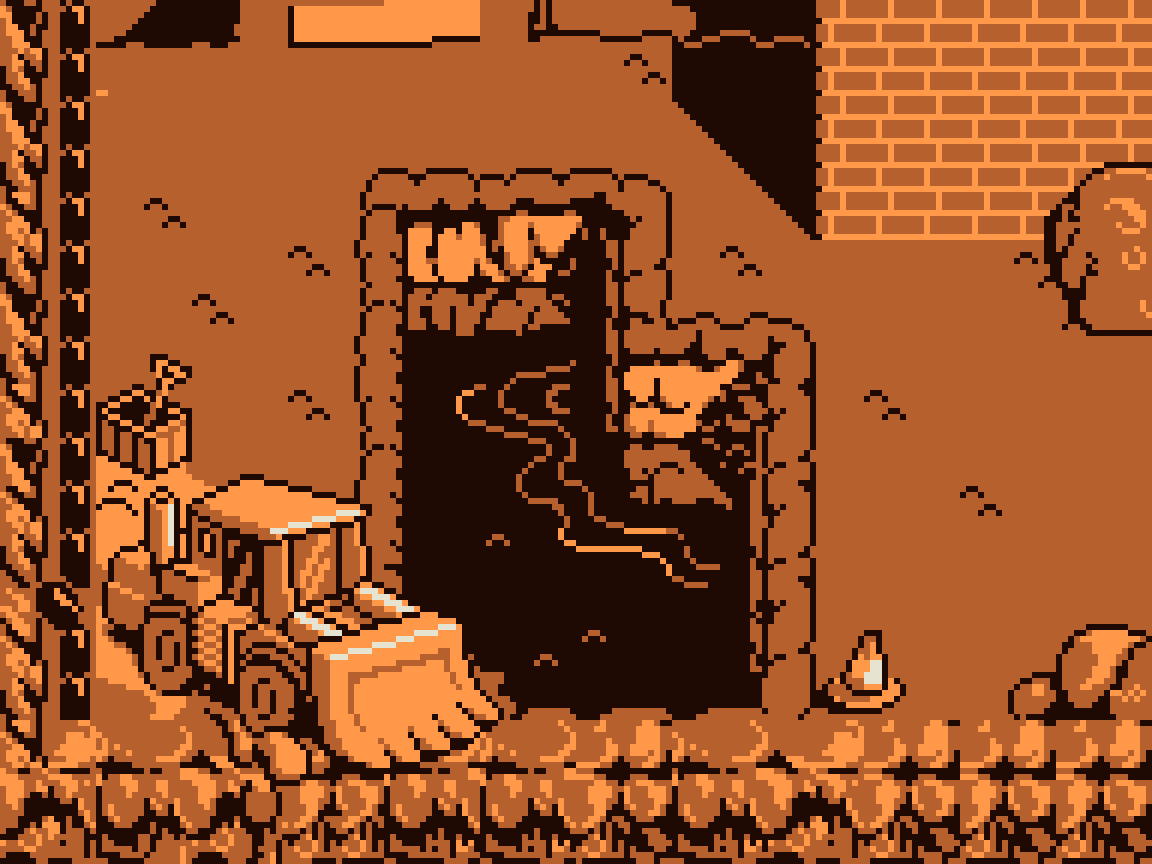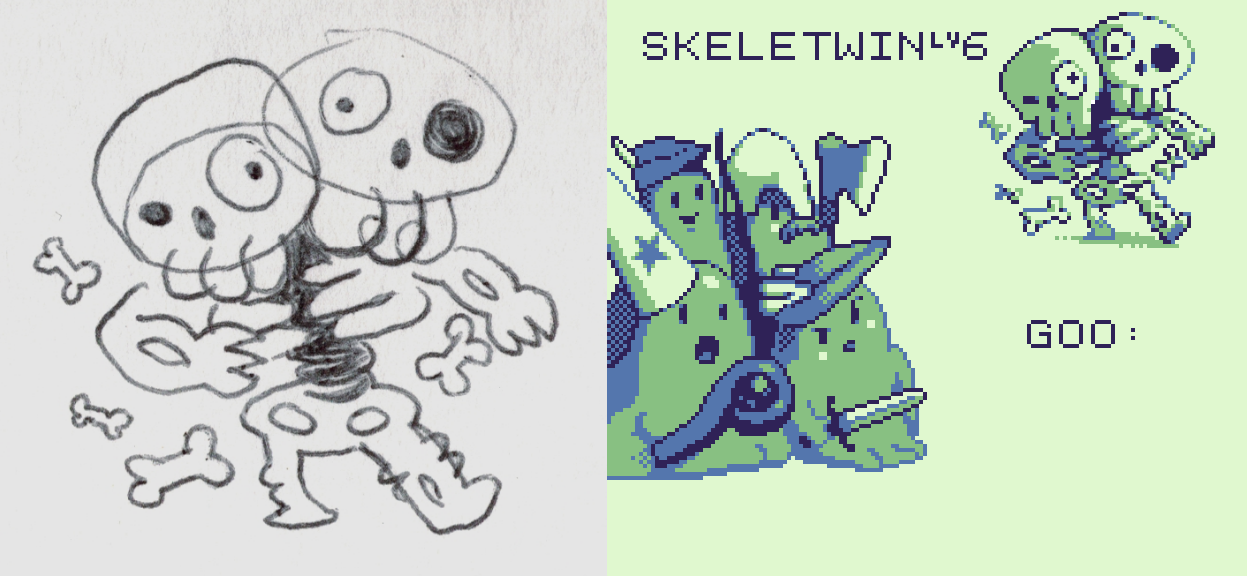Sludge & Sorcery is a quirky comedy RPG for the Game Boy that captures that classic Game Boy RPG vibe. Amazingly it was made for a Game Jam in a very short amount of time, and I asked one of its creators Polyducks some questions about the development process!
Where did the initial concept for Sludge & Sorcery come from?
Sludge and Sorcery initially started as a sketch in my notebook a few years prior – a group of slimes become unassuming heroes of the world after they slay the original party of champions. With Bitmapkid (BMK), the team’s writer, we evolved the concept into having the player play as the humans to enforce the twist.
BMK provided most of the humorous dialogue and gave the slimes their unique personalities, and the story evolved among the team as we discussed various angles we could play it from.


Sludge & Sorcery started with the artwork first.
I think the very first implementation of the idea was when I made a submission on pixeljoint for their weekly competition. The theme was “Slime Family Gathering”, and originally characters were called Cat-argh, Sally Slime and Goo-and-arrow.

It’s hard to believe the game was made in only 9 days! Could you tell us a little about what that time was like?
A lot of the team were unavailable for the actual jam, so we had permission from the jam organiser to start a week early as long as we kept track of the time we spent (9 days). A lot of work, especially the graphics, was split between a team of six, with four of us on art. I spent a lot of late nights through that week working on the game engine. Though I wrote it in GB Studio, a lot of the work was in making the platform do things that weren’t conventional like a battle system, a dialogue system, an overworld map with super small sprites and art screens with more than 192 unique tiles (we used sprites in unexpected ways).
The battle system is a lot of fun! How did it and the goo betting system originate?
The battle system was good fun to build! We considered using skills and abilities which quickly became too complicated for the nine days we had. We had to simplify it to work on a basic system, which sounds simpler than it really is. BMK is great for mechanics discussions, and he remembered that I had a game mockup from a few years ago and presented it back to me. The original mockup had competing dice combat, which was based on Steve Jackson’s SORCERY! Books.

We’ve since thought of a few refinements which could be implemented to make it feel better and more fair. The version we had for the jam wasn’t tested nearly enough and deconstructing the maths for it shows that the result for most combat relies heavily on a random outcome. There are ways around it by exploring and finding new bonuses in chests, but that isn’t immediately obvious to new players. I think if we had more time for testing at the end, we could’ve spotted this, but jam time is tight and the combat is currently serviceable with enough strategy (and luck).
People seem to really enjoy the game’s sense of humour, what was the inspiration behind it?
A lot of the humour emerged in conversation with BMK. We looked at tropes and sought to invert them and make jokes for people familiar with RPGs. The archetype of slimes are prevalent through so many games in this genre and they’re always the useless ones that the player fights at level one, so it was fun to invert that and make them far more powerful than the heroes and allow them to become the protagonists.
You can see a lot of BMK’s dry humour coming out in the dialogue, especially between the slimes. He would write pages of neatly laid out dialogue, it was really impressive to see how he constructed his scripts. From there he’d run it through a custom tool he’d made and trim it to make sure the lines delivered smoothly alongside the engine’s dialogue limits.
Some of the best jokes were written at 2:00 AM over Discord when we looked at a situation and said, “what would happen if this were DnD? What about in real life?” We had a lot of fun!
Could you tell us about the other people who contributed to Sludge & Sorcery?
The work was split between our team of seven with Rhoq, Mig Moog and Ben Jelter taking on the bulk of the artwork. AJ Booker handled the soundtrack creation. It was magnificent, he made an entire album within the nine days AND wrote it with the .mod restrictions for GB Studio!
It was difficult to organise all the separate talents into a cohesive style, but we managed it well over Discord. Rhoq and Mig Moog teamed up to handle the sprites and tiles together. We’ve been friends for a long time so we’re familiar with each other’s approach. Rhoq is a freelance game developer, so he had a good handle on things like monster sprites and Mig Moog has a good eye for tiles. He handled the overworld sprites so that I could tile them together to build them into a map. We also had some guest art from Retroshark in some of the NPC portraits.
Ben Jelter focused on the large, detailed pieces, he has a history in comic artwork, so he really knows how to make a scene dramatic or menacing. He’s also a great source of information on GB Studio (see his game Opossum Country), and gave me a few hints about breaking the tile limit. We purposefully wanted Ben Jelter’s serious and grandiose artwork to contradict the whacky and irreverent angle of the slimes to really throw it into stark contrast.

As well as programming, art and project management, I was on cleanup detail. Things like making adjustments to art for the tile limit or adding sprites where we needed them here and there. I was surprised how many little details were needed. Towards the end we all pitched in for polish in making sprites and ideas for enemy variation. It was exhausting work!

What other projects have you worked on/are working on?
Since Sludge & Sorcery I finally made the leap into becoming a full time freelance game developer. More recently in GB Studio I made a game about a monster’s dream (Waking Nightmare) which experimented with the new version 2’s colours.
In larger projects, I’ve been involved in some textmode artwork for the upcoming PS5 and XBOX game Recompile, and also doing pages and pages of sprite work for a new GB Studio game by Lance Campbell called Mud Warriors, based on a text game by Ryan Veeder. I’m excited for that, we’ve used some really smart techniques to get interesting shadows and lighting effects. Initially we were going to use a limited tileset but it turned into making custom, detailed artwork for each scene. It’s really paid off visually.
I have a few other projects coming up, but mostly it’s really exciting to be able to finally have enough time for this kind of work.

Do you have anything else you’d like to tell our readers about?
Yes! Sludge & Sorcery has a lot of tricks that most people won’t notice. Things like the dialogue system for example, which uses the maximum allowed frames to display dialogue, portraits, and character names seamlessly between up to five characters. I spent forever building that to be as flexible as possible. Because it was a game jam, much of Sludge & Sorcery was about building systems which allowed for flexibility of assets and content to be added late, so being able to have a dialogue here or a dialogue there and jumping between different character portraits was really valuable.
I think if there was a lesson I learned from this project, it’s to build flexible software in modules. That and if you want to draw complicated skeleton sprites, it really helps to draw it on paper first and use that to inform your pixels.

A massive thank you to Ben from Polyducks for his time, you can follow him on Twitter and you can play Sludge & Sorcery at https://polyducks.itch.io/sludge-and-sorcery


